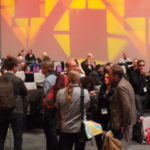It started with an offhand comment from a representative from the Bill and Melinda Gates Foundation who was moderating a session at the 2013 fall biannual meeting of the Electrochemical Society (ECS). As Christie Knef, ECS’s director of meetings, told Convene, the Gates representative looked around at the assembled brainpower — the event attracts top researchers in electrochemistry and solid-state science and technology from around the world — and said: “We have 2,000-plus experts all in one place. It’s a shame that we can’t find a way to get them all together to solve society’s problems.”
From there, “things snowballed,” Knef said. By the following autumn, ECS, with input from the Gates Foundation, had organized a “Science for Solving Society’s Problems Challenge,” which took place during a multiday workshop at the Electrochemical Energy and Water Summit in Cancun.
For the challenge, 100 researchers — selected for their relevant expertise from the conference’s more than 2,000 registered attendees — were invited to create proposals aimed at improving access to clean water and sanitation in developing countries. Some of them went on to pitch their ideas at the meeting, competing for $360,000 in funding.
Participants knew very little about the challenge when they arrived. “Essentially, right before the meeting, we identified these 100 researchers and sent them a notice to say, ‘Hey, come to a brainstorming session — there’s a chance that funding will be given out,’” Knef said. “And then we gave them more detailed information on site.”
Participants attended the brainstorming session and another working session, both of which were facilitated by RTI, a nonprofit research and development organization. With those sessions, “basically we wanted to inspire the researchers to consider the endless ways that electrochemistry can be applied to solve [water and sanitation] problems, in a way that they may not have considered,” Knef said. “Then they had two days to develop a one-page pitch. And this was all while they’re at the meeting, so they’re still giving talks and they’re still doing other things.”
It was asking a lot. “One thing about our scientists is, to tell them that they have two days to write a one-page pitch to solve a problem, that is so outside the norm for them,” Knef said. “It normally would take them months to a year to do. So this was really taking them out of their element, which was one of the most exciting things about it.
“Even a lot of our own folks [at ECS] who are scientists within our leadership and within our community were very, at first, almost put off by it,” Knef said. “Their response was, ‘This isn’t going to work. This is not what we do.’”
But it did work. Of the 100 scientists who were invited to participate, 47 turned in proposals and 30 were selected as finalists. Each finalist was given five minutes to present his or her idea to a panel of judges, followed — “Shark Tank” style — by five minutes of questions. A funding review panel announced the winning proposals the next day. The challenge organizers handed out awards to four grantees at the meeting, Knef said, but the proposals were of such high quality that three more proposals presented at the meeting later also received funding.
All seven grantees from the Cancun meeting are scheduled to present their research — including a proposal for turning urine into power — at ECS’s 2016 spring biannual meeting in San Diego this May.
“To follow through with them on their progress is very exciting,” Knef said. “It’s true reality programming. We need to keep solving these problems, and we constantly have the brightest minds at our disposal, so we need to find ways to use those assets.” The challenge, she added, “is in finding corporations and foundations that have the same interests and can align with our mission and our vision to support that.”




